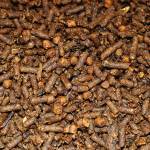Clumps in Horse Feed: Don’t Hit the Panic Button

Reputable feed manufacturers take great pains to produce well-blended, palatable horse feeds. From time to time, however, feed pours from the bag with occasional lumps or clumps, large or small. What’s a horse owner to do: grab the cellphone to lodge a complaint with the feed store, or break up the clumps and proceed with chores?
“Anytime a horse owner runs into product inconsistency, it is sound practice to take a closer look,” said Mike Lennox, head of formulation and quality assurance at Kentucky Equine Research (KER). “So long as the clumped feed looks, feels, and smells like the remainder of the feed once it’s been broken up, it can safely be fed.” If, on the other hand, something unusual is found—a foreign object, an off-putting odor, discolored grains—a call to the feed store might be appropriate recourse.
Most likely, clumping is a result of high-tech feed processing and formulation.
“Clumping happens most often in stacking and storage of feed, not during blending. Because of the robot-like precision of modern manufacturing equipment, bags are filled and stacked on pallets mechanically with optimal efficiency in mind. Bags that wind up on the bottom rows of pallets must bear more weight, which often compresses the feed, causing some clumping,” said Lennox.
One important factor in clumping involves the individual recipe of any feed. Specific feedstuffs cause more problems with clumping than others. High on this list sits molasses. Nearly all textured feeds contain molasses, but not all molasses is created equally; premium molasses is thick and extremely sticky, whereas low-quality molasses is watery and less tacky.
Another ingredient that may contribute to clumping is beet pulp, a high-fiber feedstuff that has become especially popular in recent years as an alternative energy source. The role of beet pulp in clumping is potentially twofold. “First, as a by-product of the sugar beet industry, beet pulp tends to be sticky and adhere to other ingredients in a mix,” explained Lennox. “Second, because of its shape, like Styrofoam packing peanuts, beet pulp forms a stable matrix within the mix that when combined with molasses makes a block. However, this block should be easy to break up in most circumstances.”
Whatever the causes of clumping, there is generally no need to raise an alarm with the manufacturer. While the bag of textured feed might not empty as easily or free-flowingly as a bag of straight oats, the benefits of well-fortified, high-quality feeds far outweigh the inconvenience of having to break apart lumps and clumps.
After all, who among us hasn’t encountered the occasional clump in our favorite breakfast cereal?








